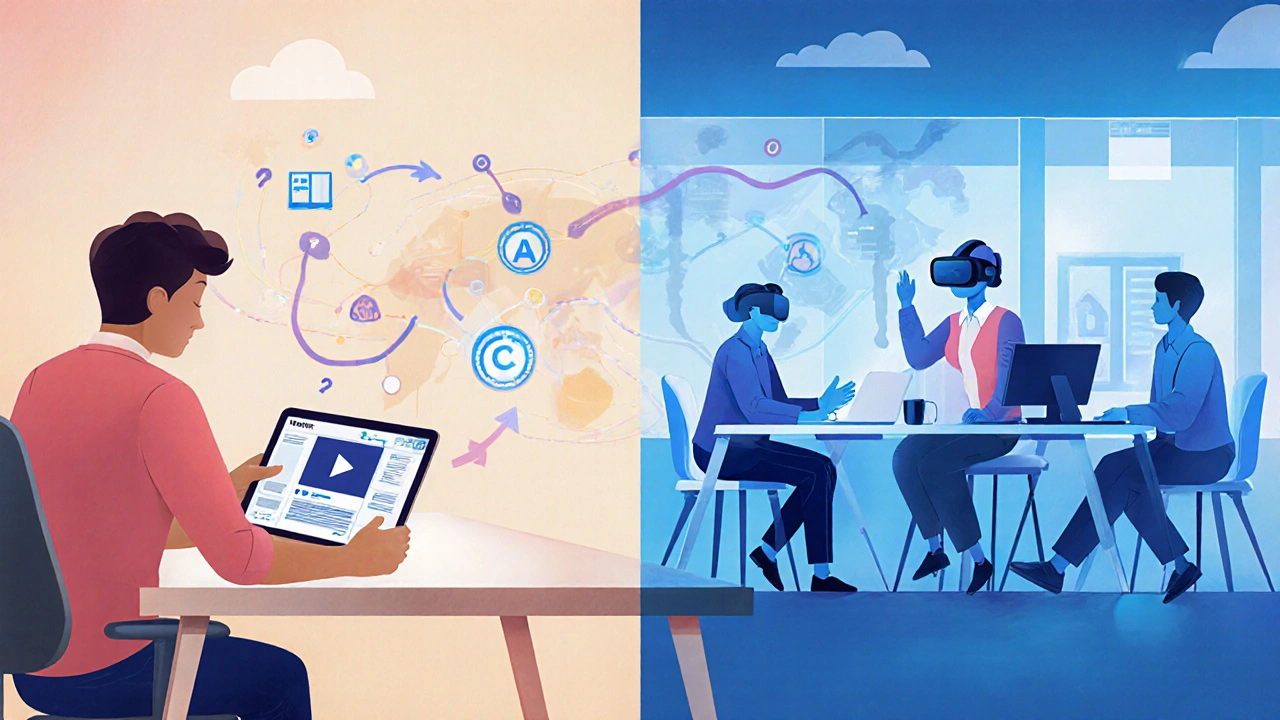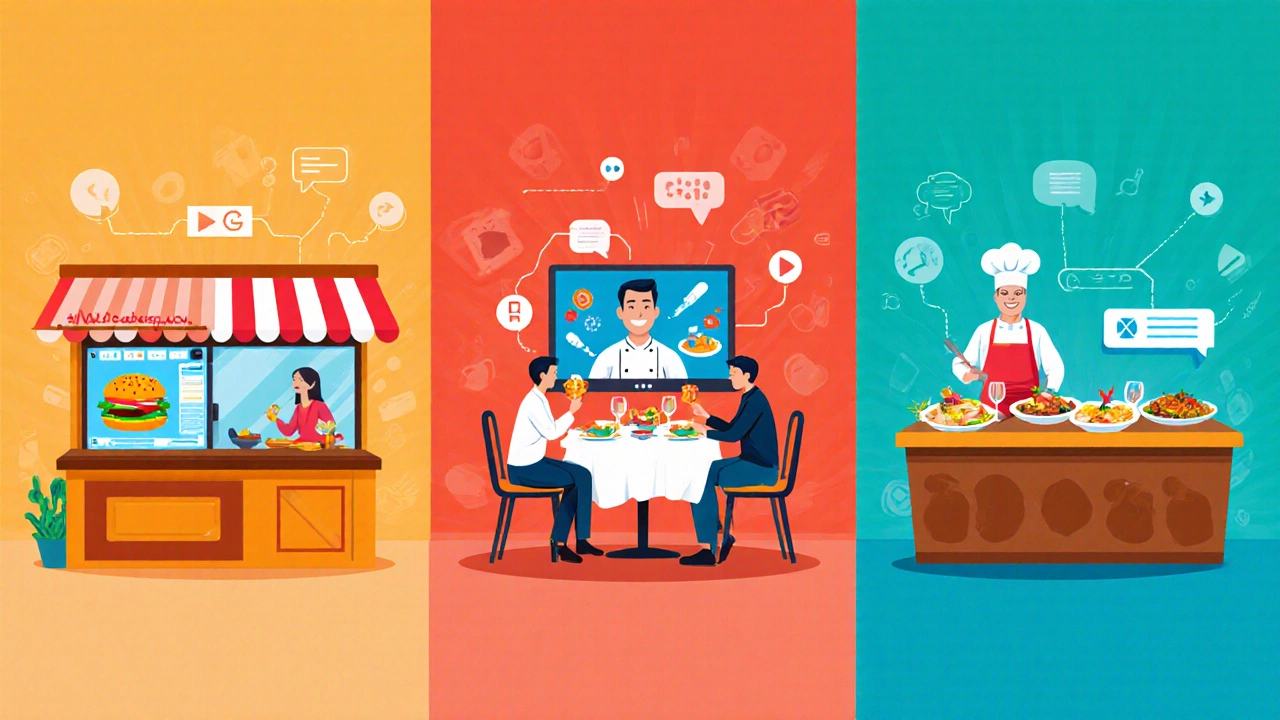When you hear the term eLearning is a digital delivery method that lets learners access content anytime, anywhere via the internet, the first question most people ask is: how does it actually work? The short answer is that eLearning isn’t a single monolith - it comes in three major flavors, each suited to different teaching goals, learner preferences, and budget constraints. Understanding these three eLearning types lets you pick the right mix for your organization, avoid costly mismatches, and keep learners motivated.
Why the distinction matters
Think of eLearning like a meal. Some people love a fast‑food burger (quick, no‑frills, self‑serve), others prefer a sit‑down dinner with a live chef (interactive, real‑time), and many enjoy a buffet that combines both. The same idea applies to digital education: if you treat all courses as the same, you’ll waste resources on unnecessary tech, frustrate learners who need live feedback, or miss the chance to scale content efficiently. Below we break down the three core types - Synchronous eLearning, Asynchronous eLearning, and Blended Learning - and show where each shines.
1. Synchronous eLearning - learning in real time
Synchronous eLearning mirrors a traditional classroom, but the classroom lives in a video‑conference window. Learners and instructors log in at the same scheduled time, share audio, video, and digital whiteboards, and interact through chat or polls.
- Key platforms: Zoom, Microsoft Teams, Google Meet, and specialized LMS add‑ons.
- Typical use cases: corporate onboarding that requires immediate Q&A, language immersion classes, exam prep sessions where timing matters.
- Advantages: instant feedback, strong sense of community, ability to adjust pacing on the fly.
- Challenges: scheduling across time zones, higher bandwidth needs, facilitator fatigue.
Because the experience is live, instructors can gauge comprehension by watching facial cues or using real‑time quizzes. This makes synchronous eLearning ideal when the learning objective hinges on discussion, negotiation, or hands‑on practice that benefits from immediate correction.
2. Asynchronous eLearning - learning on your own schedule
Asynchronous eLearning delivers content that learners can consume whenever they choose. Think of pre‑recorded videos, slide decks, PDFs, interactive simulations, and discussion forums that stay open 24/7.
- Core technology: Learning Management System (LMS) like Moodle, Canvas, or TalentLMS, which host modules, track progress, and issue certificates.
- Typical use cases: compliance training, self‑paced skill upgrades, university MOOCs, microlearning snackable bites.
- Advantages: flexibility for global teams, lower bandwidth, easy scalability, and the ability to reuse content indefinitely.
- Challenges: reduced immediacy, potential for learner isolation, higher need for self‑discipline.
When the goal is knowledge retention over time or reaching a massive audience, asynchronous eLearning wins. It also pairs well with analytics - the LMS can tell you exactly where learners stumble, letting you fine‑tune the material.
3. Blended Learning - the best of both worlds
Blended Learning (sometimes called hybrid learning) mixes synchronous and asynchronous elements into a single curriculum. A typical blend might include a self‑paced video module followed by a live workshop to practice the skills.
- Design pattern: 70% asynchronous content, 30% synchronous interaction - though the ratio can flip depending on the subject.
- Typical use cases: professional certifications that need theory study plus practical labs, university courses that combine lecture videos with weekly seminars, sales training that uses on‑demand product demos plus live role‑plays.
- Advantages: maximizes flexibility while preserving human connection, improves knowledge transfer, and often yields higher completion rates.
- Challenges: requires careful coordination, more complex tech stack (LMS + video conference), and clear communication of schedules.
Blended Learning is essentially a strategic decision: you decide which content should be consumable anytime and which interactions demand a live facilitator. When executed well, it reduces the total instructor hours while still delivering a rich, engaging experience.
Side‑by‑side comparison
| Attribute | Synchronous | Asynchronous | Blended |
|---|---|---|---|
| Interaction level | High - real‑time Q&A, polls, breakout rooms | Low - forums, automated quizzes | Medium - mix of live sessions and self‑study |
| Delivery mode | Live video/audio, shared screen | Pre‑recorded media, PDFs, SCORM packages | Combination of both |
| Typical tools | Zoom, Teams, Webex | Moodle, Canvas, Coursera, Udemy | LMS + video conference suite |
| Ideal audience | Teams requiring immediate feedback (sales, customer service) | Global, self‑motivated learners (compliance, MOOCs) | Organizations wanting flexibility but still need live practice (engineers, clinicians) |
| Scalability | Limited by facilitator bandwidth | Highly scalable - one recording serves many | Scalable with proper planning; hybrid load balancing |
How to choose the right mix for your project
- Define learning objectives. If you need learners to apply skills instantly, prioritize synchronous or blended. If the goal is knowledge acquisition, asynchronous may suffice.
- Map audience constraints. Consider time zones, internet bandwidth, and digital literacy. Global teams often lean toward asynchronous modules.
- Budget reality check. Synchronous sessions cost instructor hours per session; asynchronous content incurs higher upfront production costs but lower ongoing expenses.
- Technology stack assessment. Verify your LMS can host both media types and integrate with video‑conference APIs.
- Pilot and iterate. Release a mini‑module in one format, gather learner feedback, then adjust the blend. Data from LMS analytics (completion rates, quiz scores) guide refinements.
Following this checklist prevents the classic mistake of over‑engineering a course that ends up being too rigid or too vague.
Implementation tips for each type
Synchronous
- Send calendar invites with clear agenda and time‑zone conversion.
- Test audio/video equipment 10 minutes before start.
- Use a co‑facilitator to manage chat, polls, and breakout rooms.
- Record the session for those who can’t attend and for post‑session review.
Asynchronous
- Chunk content into 5‑10 minute videos to keep attention.
- Embed knowledge checks after each chunk to reinforce learning.
- Leverage microlearning - short, focused lessons that fit into a coffee break.
- Provide a discussion forum with scheduled moderator check‑ins.
Blended
- Start with self‑paced modules, then schedule live labs to practice.
- Make a “roadmap” visible in the LMS so learners see when live sessions occur.
- Use analytics from the asynchronous part to tailor live session difficulty.
- Collect post‑session surveys to gauge how well the blend worked.

Common pitfalls and how to avoid them
- Assuming one size fits all. Not every learner thrives in a live video room; offer alternatives like subtitles or transcripts.
- Neglecting tech support. A bad connection can ruin a synchronous class. Have a standby help‑desk.
- Forgetting engagement metrics. Rely on LMS reports - completion rates below 70% usually signal content overload or poor relevance.
- Overloading learners with tools. Stick to 2‑3 core platforms; extra apps cause confusion.
Future trends shaping the three types
Artificial intelligence is already personalizing asynchronous pathways - an AI engine can reorder modules based on quiz performance. Meanwhile, virtual‑reality rooms are enhancing synchronous labs for fields like medicine and engineering. Blended Learning is becoming data‑driven: the LMS will auto‑suggest live session dates based on learner progress patterns. Keeping an eye on these trends ensures your eLearning strategy stays ahead of the curve.
Frequently Asked Questions
What is the main difference between synchronous and asynchronous eLearning?
Synchronous eLearning happens live, with learners and instructors interacting in real time, while asynchronous eLearning provides pre‑recorded or self‑paced content that learners access whenever they choose.
Can I use a single LMS for all three eLearning types?
Yes. Modern LMS platforms support hosting asynchronous modules, embed live‑stream links for synchronous sessions, and schedule blended activities, making them a one‑stop solution.
How do I decide the right blend ratio for blended learning?
Start by listing learning outcomes. If knowledge acquisition dominates, allocate more to asynchronous content (e.g., 70%). If skill practice or discussion is crucial, increase live session time. Pilot with a small group and adjust based on feedback and analytics.
What are typical costs for each eLearning type?
Synchronous costs are driven by facilitator hours and video‑conference licenses. Asynchronous incurs higher upfront production (script, video, design) but lower ongoing delivery expenses. Blended combines both, so budget for content creation plus a modest amount of live facilitation.
Is microlearning considered a separate eLearning type?
Microlearning is a delivery style rather than a distinct type; it can be used within both asynchronous modules and blended courses to deliver bite‑size lessons that fit busy schedules.

Write a comment